Integrated Management of White Mold on Vegetables in Florida1
Host Range
Brussels sprouts, cauliflower, cabbage, carrot, collards, eggplant, green beans, lettuce, pepper, potato, squash, melon and other cucurbits, and tomato are some of the vegetable crops grown in Florida that are susceptible to one of several Sclerotinia spp. that cause a disease often referred to as white mold (Figures 1 and 2). Collectively, Sclerotinia spp. can cause disease in more than 400 plant species. Lettuce drop, head rot of cabbage (Figure 3), Sclerotinia stem rot of collards (Figure 4), Sclerotinia crown and root rot, pink rot, and watery soft rot are other common names of diseases caused by Sclerotinia spp., and they are often descriptive of the symptoms.
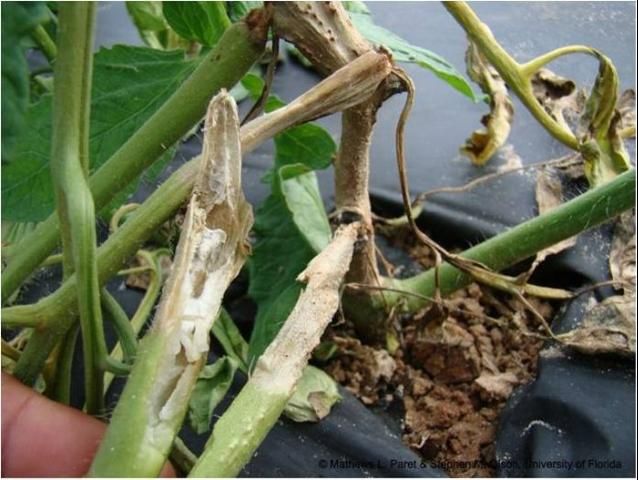
Credit: Mathews L. Paret
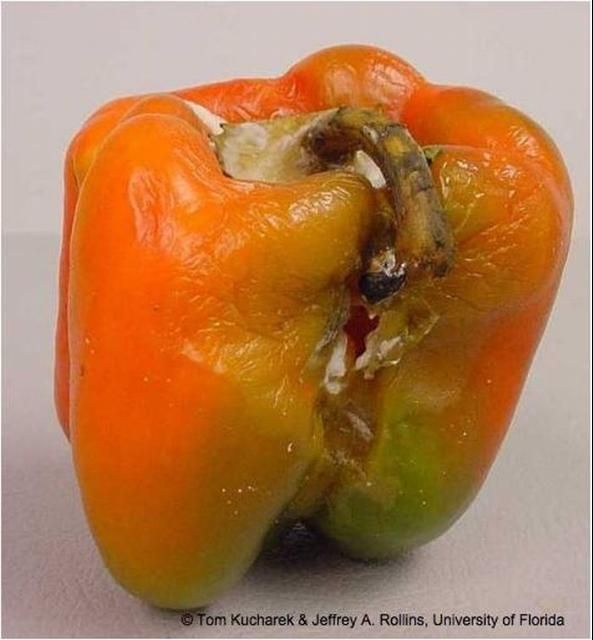
Credit: Tom Kucharek and Jeffrey A. Rollins
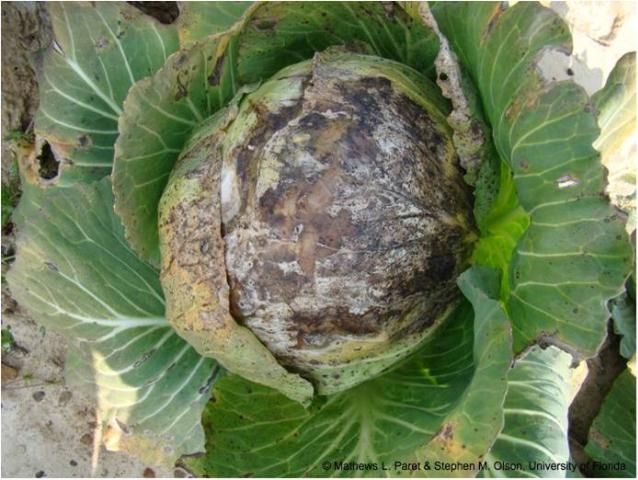
Credit: Mathews L. Paret
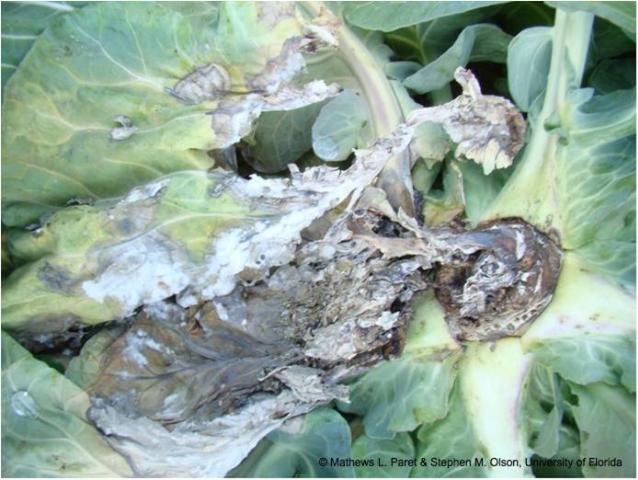
Credit: Mathews L. Paret
Symptoms
White mold causes water-soaked lesions on the leaves and the crown of the plant (Figure 5), head rot (Figure 6), fruit rot (Figure 2), and stem rot on infected vegetables (Figure 7). The necrotic areas of the plant are often covered with a fluffy mass of white mycelia, as seen in cabbage (Figure 8), brussels sprouts (Figure 9), and tomato (Figure 10). The hyphae of the mycelium (mass of fungal strands) gradually aggregate together and condense with the accumulation of melanin to form dry structures called sclerotia (Figure 11).
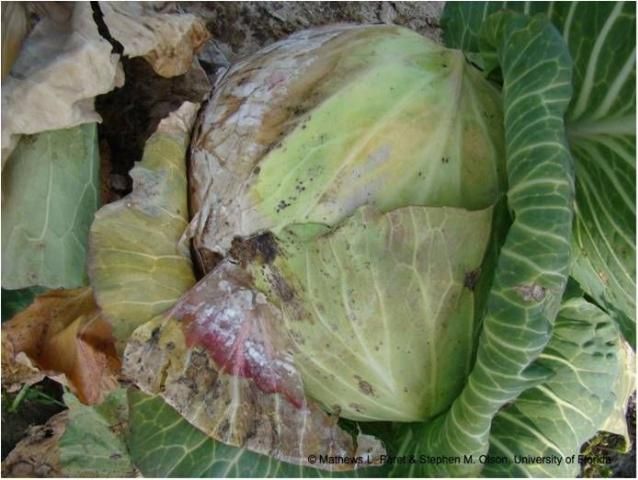
Credit: Mathews L. Paret
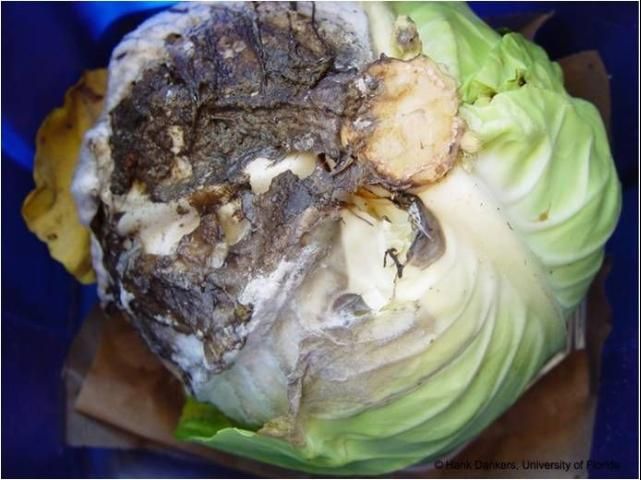
Credit: Hank Dankers
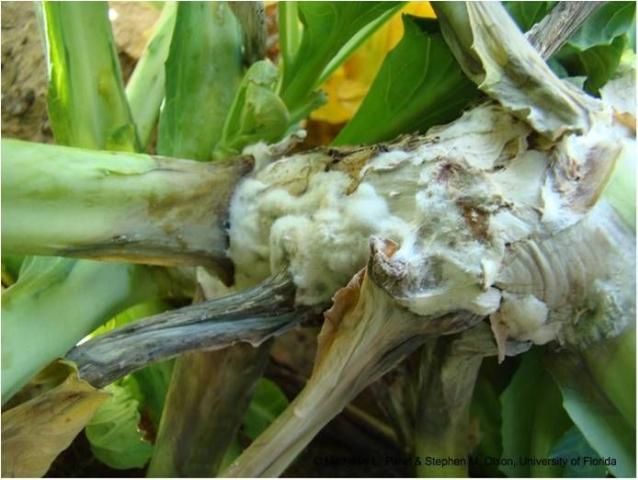
Credit: Mathews L. Paret
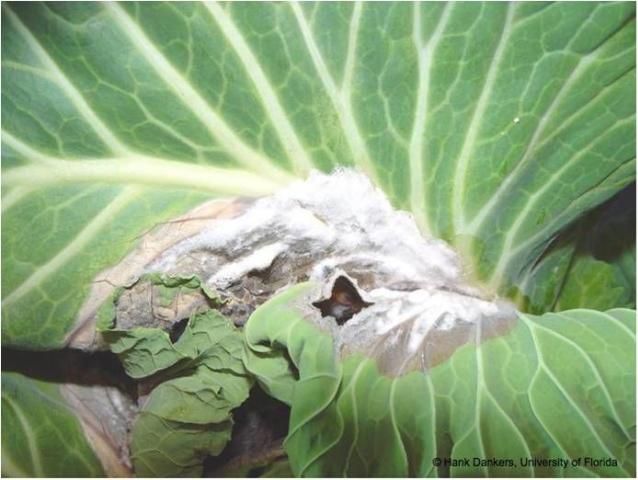
Credit: Hank Dankers
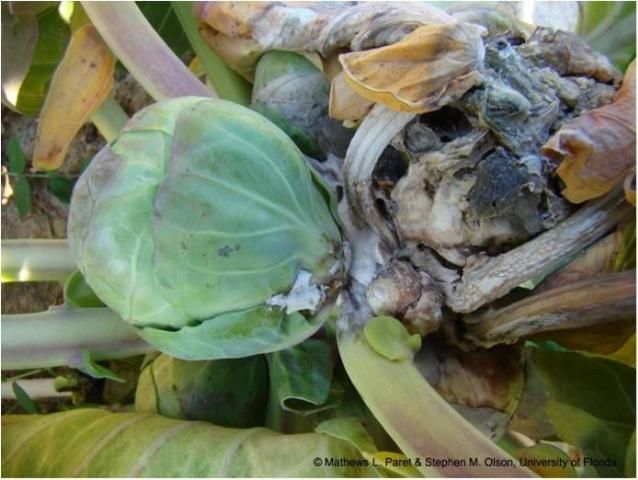
Credit: Mathews L. Paret
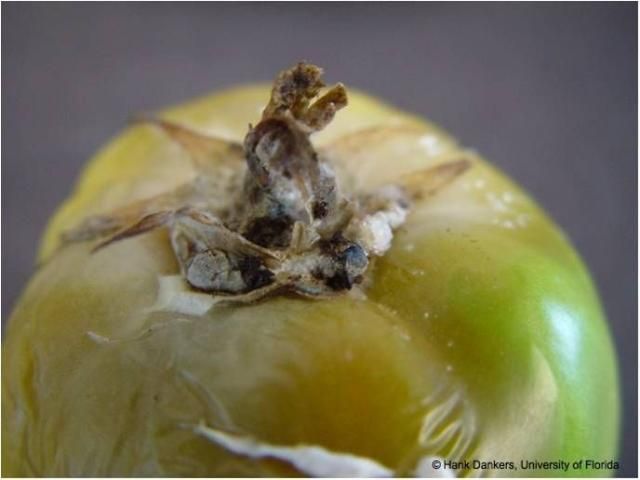
Credit: Hank Dankers

Credit: Nicholas S. Dufault
The sclerotia can be seen attached to the mold-like mycelium that is formed on the infected area of the plant; upon severe infection, it is also visible on the soil line. The sclerotia are black in color and vary in size from a few millimeters to a centimeter (Figure 12). On brussels sprouts, the infected area takes on a unique bird's nest appearance at the top of the plant (Figure 13). Severe tissue degradation that leads to rotting is a major symptom in most of the vegetable crops infected by S. sclerotiorum (Figure 14). In some crops, like green beans, pepper, and tomato, mycelia are not always observed on the stem, but actually grow internally where sclerotia develop as well (Figure 15). The infected stems have a blighted appearance (Figure 16).
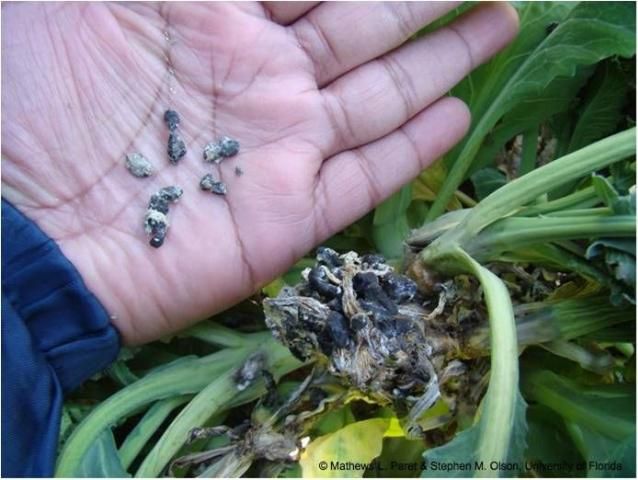
Credit: Mathews L. Paret
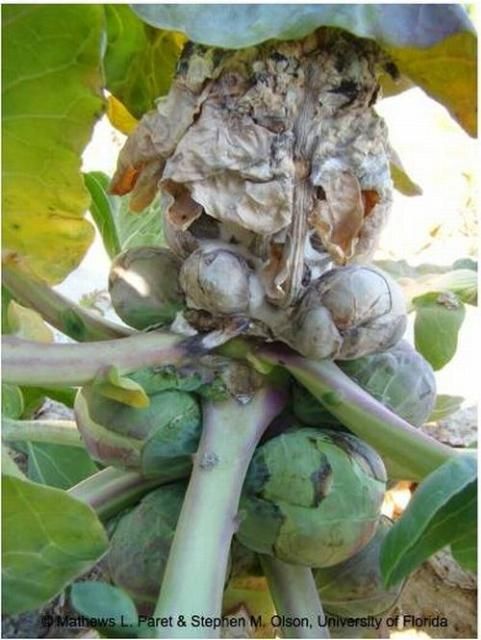
Credit: Mathews L. Paret
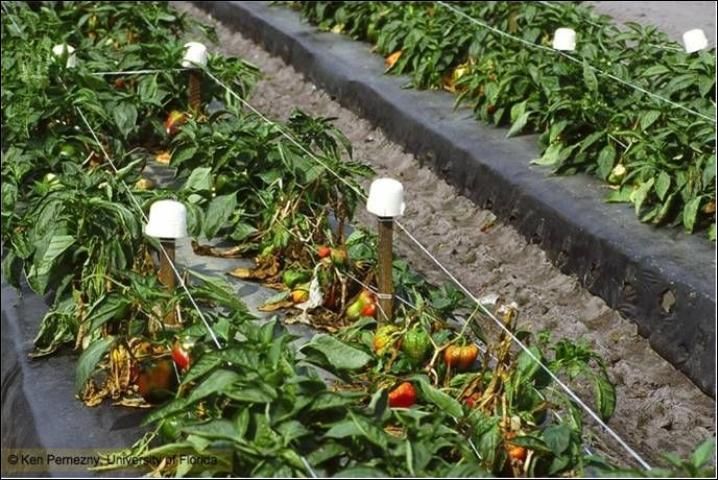
Credit: Ken Pernezny
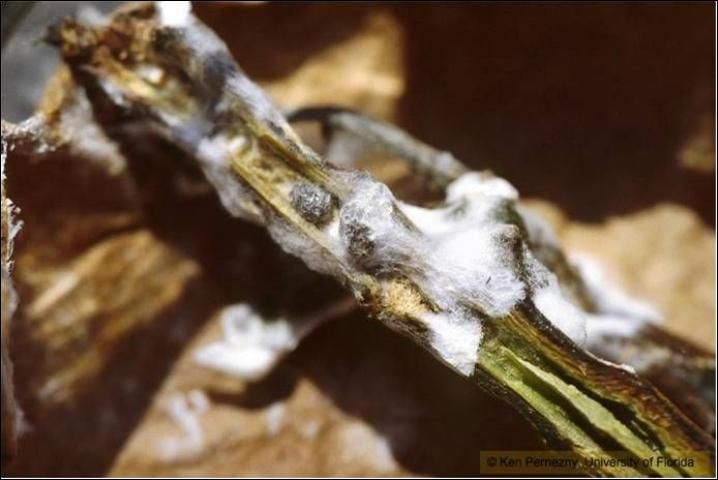
Credit: Ken Pernezny
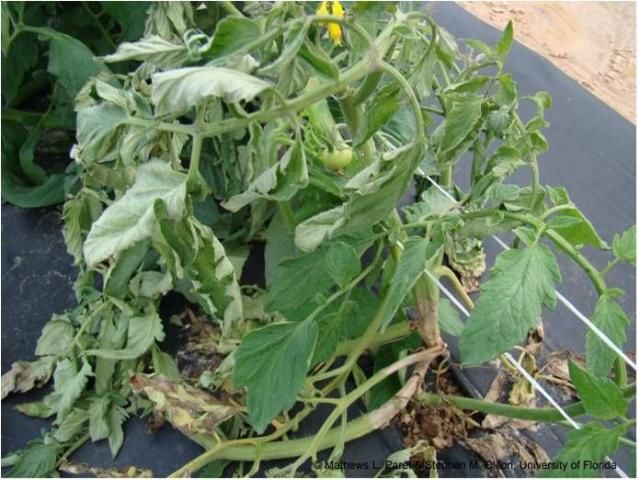
Credit: Mathews L. Paret
Causal Agent
The ascomycete fungus S. sclerotiorum is the primary causal agent for white mold. In addition, two other species of Sclerotinia, S. minor and S. trifoliorum, are disease problems in the United States. S. minor is primarily a pathogen of lettuce, celery, carrot, and peanut; S. trifoliorum is known to infect green beans and legumes and is similar in biology and morphological characteristics to S. sclerotiorum. S. sclerotiorum produces large (2–10 mm in diameter) sclerotia, while S. minor produces smaller sclerotia (0.5–2 mm), and this is one of the distinguishing features. However, the major differentiation is the primary modes of infection used by these two species to infect a plant. S. minor infects by eruptively germinating sclerotia that are near the taproot system of the plant; therefore, it is primarily a soilborne organism. Spore production by S. minor is rarely seen in nature. Lesions mostly develop on the stem, followed by vascular invasion of the mycelium, which leads to plant wilt and collapse. In contrast, while S. sclerotiorum can also be soilborne, it primarily infects plants through airborne ascospores (Figure 17). The ascospores land on the plants and produce mycelia that invade the tissues rapidly, which leads to plant collapse.
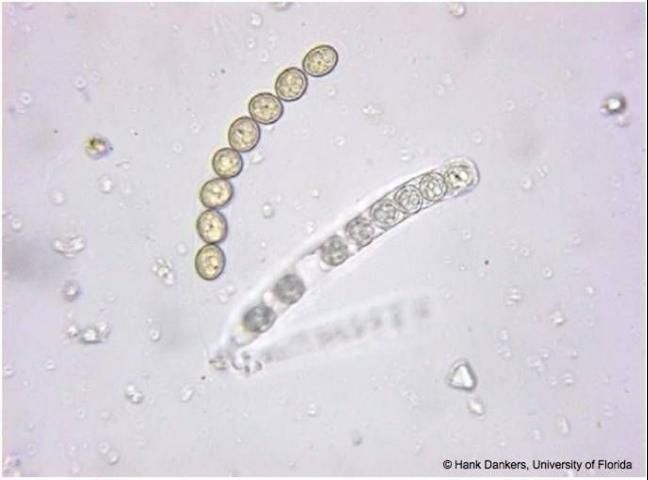
Credit: Hank Dankers
Disease Cycle
Sclerotia are the primary survival structure for Sclerotinia spp. and are capable of remaining dormant for several years (e.g., 5 to 7 years) in soil. The fungus can enter a field through various means, including contaminated seed and plant debris (Figure 18), movement of infected soil on farm equipment, and movement through surface water. Sclerotia overwinter and germinate, producing either mycelia that can directly infect the basal region of the stem of certain plants (this process is referred to as "mycelogenic germination"; Figures 19b–23), or forming a small, mushroomlike fruiting body called an apothecium (this process is referred to as "carpogenic germination"; Figure 19a and 24). In carpogenic germination, the apothecium produces numerous asci that contain specialized spores known as ascospores, which are discharged and blown by wind to aerial portions of the plant. The ascospores produce mycelia that subsequently infect the plant.
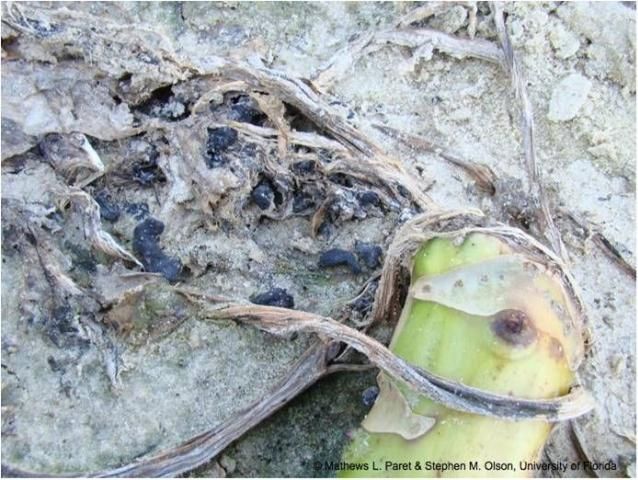
Credit: Mathews L. Paret
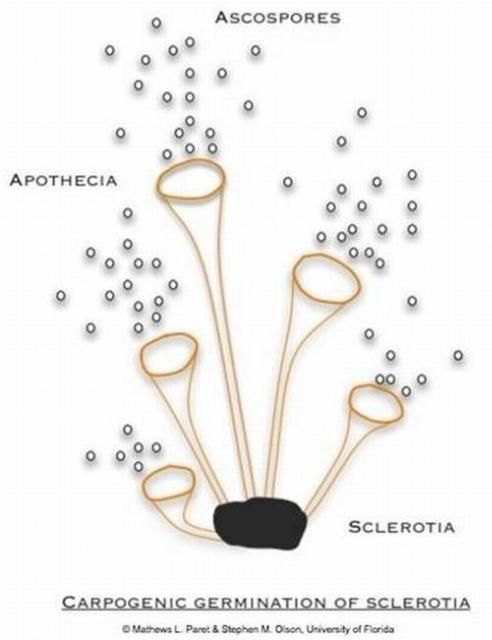
Credit: Mathews L. Paret

Credit: Mathews L. Paret
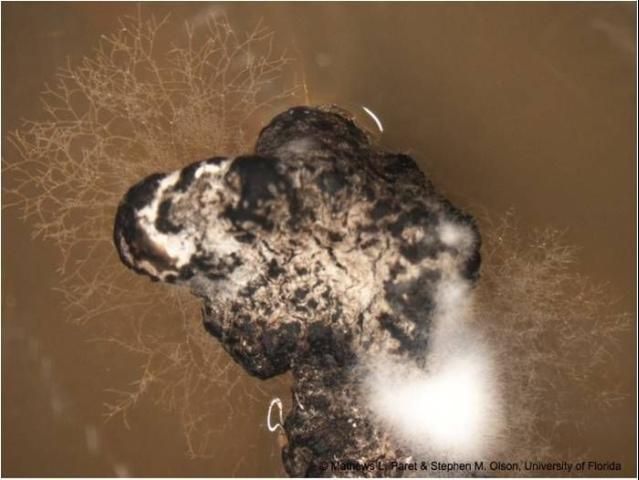
Credit: Mathews L. Paret
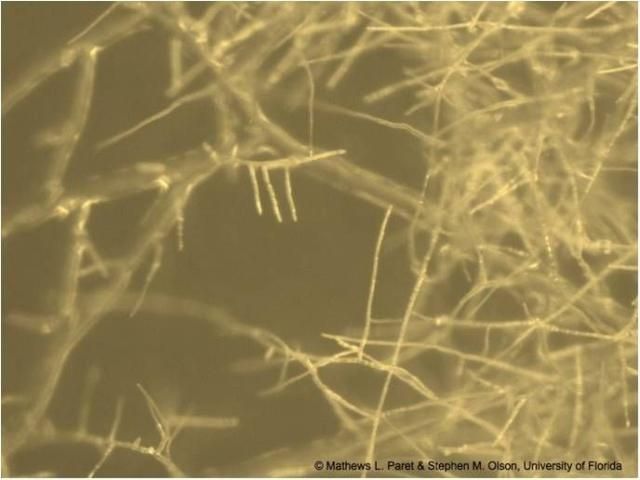
Credit: Mathews L. Paret
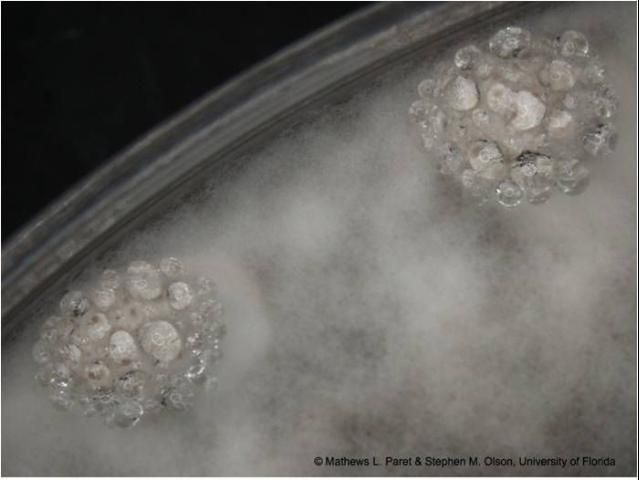
Credit: Mathews L. Paret
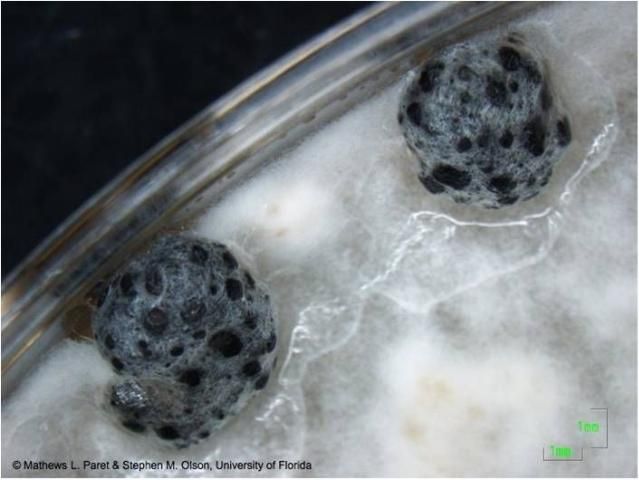
Credit: Mathews L. Paret
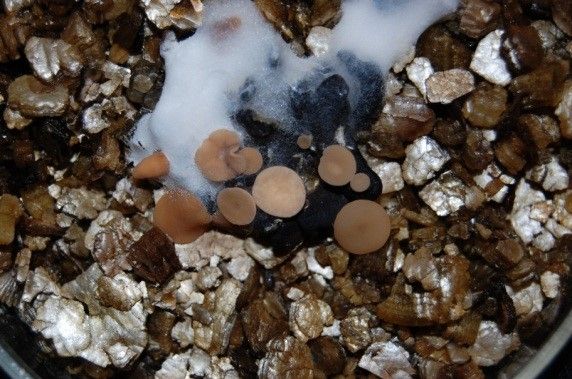
Credit: Nicholas S. Dufault
Management
The first step in white mold management is avoiding the spread of the fungus through surface water, farm equipment, farm workers, and seed or planting material. An important aspect in the spread of the fungus is that each apothecium (Figures 17 and 24) releases millions of ascospores that are rapidly spread by wind. Therefore, vegetable fields should be monitored regularly for disease, recognizing that areas where white mold occurred previously are likely to be problematic in subsequent seasons. The disease can be successfully managed by integrating the approaches described below.
Field Plowing
Sclerotia of S. sclerotiorum can germinate carpogenically from depths of 4–5 cm below the soil line. Therefore, infested crop debris should be deep tilled with a moldboard plow before planting the next crop in the field. This will move the sclerotia into deep layers of the soil where they will not germinate. However, this is only a good management strategy for a single season, as subsequent tillage will bring buried sclerotia back to the surface in the next growing season.
Crop Density Management
Optimum row spacing of the plants must be kept to create a microclimate condition that is not favorable for survival of the fungus. In addition, varietal selection is important to prevent excessive overlap of the leaves of adjacent plants. This will ensure good airflow that will reduce high moisture conditions in vegetable production.
Irrigation Management
Leaf moisture is a key aspect in the development of white mold. S. sclerotiorum spreads primarily during flowering or in the early stages of plant growth when ascospores can easily colonize the plant due to high levels of water on the leaves. The duration of leaf wetness should be reduced in vegetable cultivation under sprinkler irrigation systems. This can be achieved by initiating an early-morning irrigation schedule to allow sufficient time for the leaves to dry during the day. Subsurface drip irrigation is known to be less conducive to disease development than furrow irrigation in the case of lettuce drop caused by S. minor. Previous studies indicate that the combination of high temperature, high soil moisture, and reduced oxygen in irrigated fields can reduce the survival of Sclerotinia spp.
Crop Rotation
Because sclerotia can survive in soils for many years, crop rotation can only be successful if long-term rotation is practiced. Rotation with nonhost crops, such as corn, wheat, and sorghum, can reduce the number of viable sclerotia of S. sclerotiorum in the upper soil. In the case of lettuce drop caused by S. minor, rotation of broccoli with lettuce has been previously shown to reduce the number of sclerotia in the field. Canada thistle, Jerusalem artichoke, lambsquarters, mustard, nightshade, pigweed, ragweed, shepherd's purse, sow thistle, velvetleaf, and vetch are common weeds described before as hosts to S. sclerotiorum and should be eradicated from the production area of susceptible crops. The United States Department of Agriculture plants database (http://plants.usda.gov/) can be used to identify these weeds.
Varietal Selection
Early-maturing varieties that have less of a tendency to spread should be selected when possible. Resistant sources to the white mold fungus in vegetables are scarce. However, high levels of resistance to S. sclerotiorum have been noticed in various Capsicum spp.
Biological Control
Management of S. sclerotiorum using the fungus Coniothyrium minitans is effective in reducing the disease. Dried spores of this biological control agent can be sprayed on pathogen-infested plant debris at the end of a growing season and on soil before planting. The parasitized sclerotia produce fewer apothecia, which reduces disease incidence. Streptomyces lydicus, Bacillus subtilis, and Bacillus pumilis are other biological control agents that can be used for disease management. Biocontrol agents that are currently labeled for use in Florida are provided in the Vegetable Production Handbook for Florida (https://edis.ifas.ufl.edu/pdffiles/CV/CV29500.pdf).
Chemical Control
Fungicides are available for chemical control and are labeled for use in some vegetable crops in Florida. Fungicides that are currently labeled for use in Florida are provided in the Vegetable Production Handbook for Florida (https://edis.ifas.ufl.edu/pdffiles/CV/CV29500.pdf).
Control measures should be undertaken early in the season to reduce chances of severe infection and to reduce the buildup and carryover of sclerotia to the following season. An integrated management practice incorporating the various available cultural, biological, and chemical control methods is essential for the successful management of white mold on vegetable crops in Florida.
References
Budge, S. P., and Whipps, J. M. 2001. "Potential for integrated control of Sclerotinia sclerotiorum in glasshouse lettuce using Coniothyrium minitans and reduced fungicide application." Phytopathology 91: 221–227.
Gerlagh, M., Goossen-van de Geijn, H. M., Fokkema, N. J., and Vereijken, P. F. G. 1999. "Long-term biosanitation by application ofConiothyrium minitans on Sclerotinia sclerotiorum-infected crops." Phytopathology 89: 141–147.
Hao, J. J., and Subbarao K. V. 2005. "Comparative analyses of lettuce drop epidemics caused by Sclerotinia minor and S. sclerotiorum." Plant Disease 89: 717–725.
Hao, J. J., Subbarao, K.V., and Koike, S. T. 2003. "Effects of broccoli rotation on lettuce drop caused by Sclerotinia minor and on the population density of sclerotia in soil." Plant Disease 87: 159–166.
Heffer Link, V., and Johnson, K.B. 2007. White Mold. The PlantHealth Instructor. DOI: 10.1094/PHI-I-2007-0809-01. https://www.apsnet.org/edcenter/disandpath/fungalasco/pdlessons/Pages/WhiteMoldPort.aspx
Momol, T., and Pernezny. K. 2006. Florida Plant Disease Management Guide: Tomato. PDMG-V3-53. Gainesville: University of Florida Institute of Food and Agricultural Sciences. https://edis.ifas.ufl.edu/pg059
Pernezny, K., and Purdy, L.H. 2009. Sclerotinia Diseases of Vegetables and Field Crops in Florida. PP22. Gainesville: University of Florida Institute of Food and Agricultural Sciences. http://ufdcimages.uflib.ufl.edu/IR/00/00/34/27/00001/VH01500.pdf
Rollins, J. A. Sclerotinia sclerotiorum resource page. http://www.sclerotia.org/
Subbarao, K. V., Hubbard, J. C., and Schulbach K. F. 1997. "Comparison of lettuce diseases and yield under subsurface drip and furrow irrigation." Phytopathology 87: 877–883.
Wu, B. M., and Subbarao, K. V. 2008. "Effects of soil temperature, moisture, and burial depths on carpogenic germination of Sclerotinia sclerotiorum and S. minor." Phytopathology 98: 1144–1152.
Wu, B. M., Subbarao, K.V. and Liu, Y.B. 2008. "Comparative survival of sclerotia of Sclerotinia minor and S. sclerotiorum." Phytopathology 98: 659–665.
Yanar, Y., and Miller S. A. 2003. "Resistance of pepper cultivars and accessions of Capsicum spp. to Sclerotinia sclerotiorum." Plant Disease 87: 303–307.
Zhang S, Palmateer, A., and Pernezny, K. 2017. Florida Plant Disease Management Guide: Beans. PDMG-V3-33. Gainesville: University of Florida Institute of Food and Agricultural Sciences. https://edis.ifas.ufl.edu/pg041
Zotarelli, L., P. J. Dittmar., M. Ozores-Hampton., N. S. Dufault., B. Wells., J. W. Noling., E. J. McAvoy., Q. Wang., C. F. Miller 2017. "Cole Crop Production." In: Vegetable Production Handbook for Florida, edited by G. E. Vallad., H.


